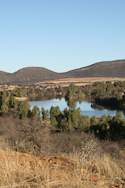The Grasslands Biome

The Vredefort Dome is situated in the Grasslands biome, on the cusp between the Highveld and the Transvaal plateau.
The grass type is usually classed as Bankenveld, but the unique geological heritage of the area results in many unusual variations. For example, Bushveld species normally found hundreds of kilometers to the north are present, such as Bush Willow, Red Ivory and Tree Ferns.
The riverine bush along the banks of the Vaal also adds to the biodiversity. In the nooks and crannies of the Dome, a variety of microhabitats, microclimates and soil types succour many plant communities. A complete list of flora has not yet been completed, but there are at least 99 plant species present in the area.
Wild Olive trees are particularly common and the world’s largest natural plantation of this species (Olea europaea subsp. africana) is found on a koppie just outside of Parys. Acacia and Protea species are also widespread.
Alien Plant Species
Alien plant species are a problem in the Dome. Gum trees are encroaching along the fertile Vaal floodplain. Poplar, Weeping Willows and several species of Prickly Pear are also pushing out the indigenous vegetation. Water hyacinths are a particular nuisance, as they proliferate in the Vaal River and clog up the waterways. Quite a lot of work will have to be done to restore the area to its native splendour.
Birdlife is abundant, however, with more than 200 species to keep the twitchers happy. These include: cormorants, herons, egrets, spoonbills, vultures, eagles, kites, falcons, kestrel, guineafowl, lapwings, sandpipers, owls, nightjars, swifts, mousebirds, kingfishers, rollers, barbets, woodpeckers, swallows, martins, cisticolas, starlings, sunbirds, widowbirds, bishops, warblers, chats and tits. The Inlandsee Pan, near Vredefort, is also an important meeting place for migratory birds.
Red Data Species
Although the Dome used to be home to the Big 5, all the larger animals were hunted out as farmers took over the land. Nevertheless, there are still 50 species of small mammals to be found, including eight "Red Data Species".
Leopard, rooikat, aardwolf, jackal, rock dassies and antelope are present, and several game farms and nature reserves are currently restocking the region’s wildlife. Vredefort also has a full contingent of creepy-crawlies, snakes, scorpions and insects. There is a notable wealth of butterfly species, so if you’re a lepidopterist, this is the place for you! In fact, it is said that there are more butterfly species in the Dome than in the whole of the British Isles.
Apart from the Vaal River, the Dome is kept watered by a good average rainfall of 625 mm, 500 m of which falls in the summer months. Droughts, however, are not uncommon. In summer, the temperature is hot, averaging 30°C maximum to 15°C minimum during the day. Winter days are warm (around 18°C) but nights can be pretty darn cold.
By David Fleminger